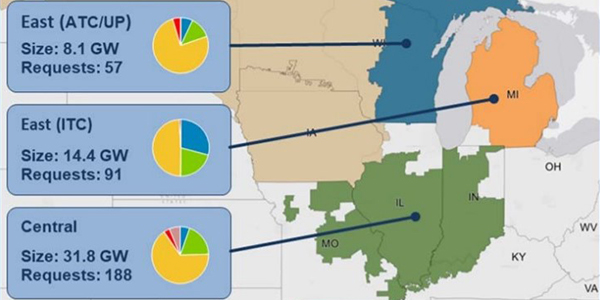By Amanda Durish Cook
CARMEL, Ind. — MISO will pull back on a plan to create a special lane in its interconnection queue to accelerate the process for projects that demonstrate readiness for development.
The move — announced Tuesday at the Interconnection Process Working Group (IPWG) — represents MISO’s second about-face on the issue. After last year resisting wind developers’ pleas to create, the RTO early this year said it would develop a fast-track option, with staff floating possible approaches in March. (See MISO Details Fast-track Queue Options.)
The effort would have created a separate, expedited definitive planning phase (DPP) designed to allow select projects with documented evidence they would be complete in about three to six months.
“We’ve decided to put this on hold until further notice,” Resource Interconnection Planning Manager Neil Shah told the IPWG.
Shah said stakeholder reaction to the March presentation persuaded MISO to change course. He said a fast-track option does not have general support, with stakeholders instead urging the IPWG to improve the existing process rather than “developing a parallel path.”
“Basically, stakeholders want us to improve efficiency for the existing DPP. They think it’s not the right time for it.”
Shah said some stakeholders pointed out that an expedited DPP “may not help projects where state regulations mandate certificates of public convenience and need,” typically a two-year process.
But BayWa r.e. renewable energy’s Patrick Brown urged MISO to not “flush away” the proposal, but “flesh it out more.”
“If you have a [power purchase agreement], you’re clamoring for this,” Brown said, adding that there must be multiple developers in MISO’s interconnection queue that can demonstrate readiness.
MISO’s queue is once again at an all-time high, now at 640 projects totaling 100.7 GW, with 297 projects totaling nearly 44 GW having entered the queue this year before the April 29 window close. Solar accounts for about 210 of the new projects, at nearly 30 GW.
The total queue is now about 86% wind and solar projects, with proposed solar generation (59 GW) overtaking wind (27 GW). Proposed storage projects represent about 3 GW, while natural gas projects represent more than 9 GW.
MISO’s queue topped out at about 90 GW in 2018 but had fallen to about 70 GW by March because of withdrawing projects.
The RTO is only suspending the fast-track effort, not completely closing the door on the idea, Shah said, noting his staff will continue to monitor any shift in stakeholder opinions. He also pointed out there other there are “other avenues” stakeholders can pursue within the Tariff if they are simply looking to accelerate the construction of projects.
Additionally, MISO now plans to perform an intensive examination of how projects advance the queue, looking specifically at project modeling, the DPPs and agreement negotiation.
MISO Manager of Resource Interconnection Arash Ghodsian said interconnection staff will follow the April 2018 cycle of projects and collect data to examine how to reduce the length of time projects spend in the interconnection process.
“The goal is to come back in July and talk about the model development stage, talk about the process, the successes and challenges, and the opportunities for improvements,” Ghodosian said.
“There are no intentions at this point to file anything,” he added. He said any possible solutions will be arrived at “collaboratively” with stakeholders.





